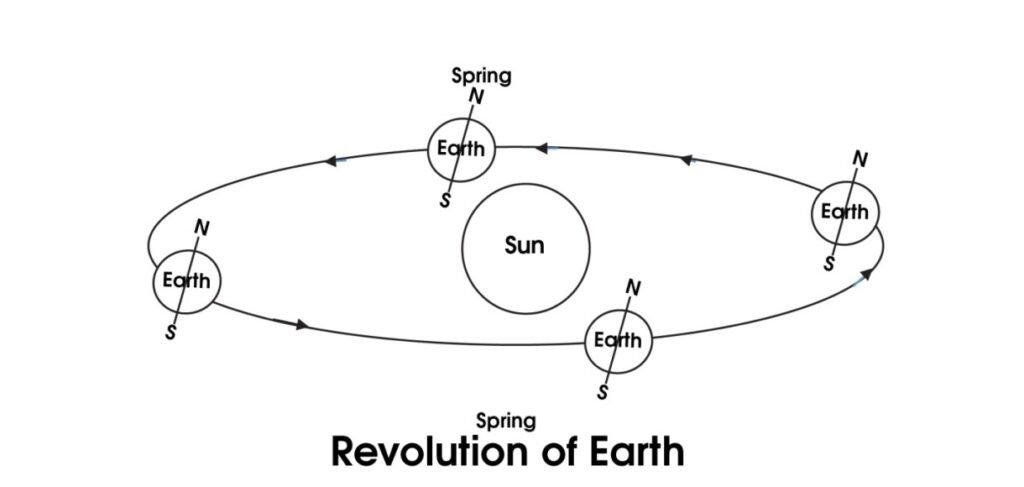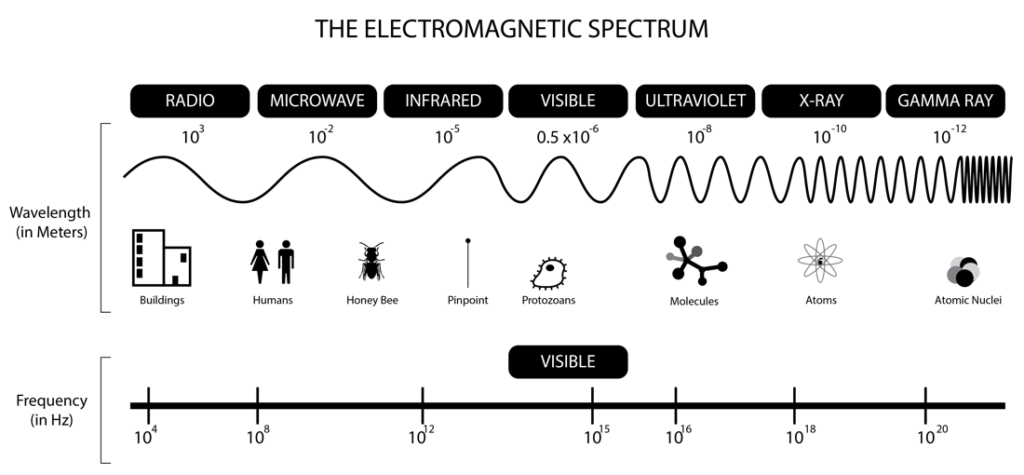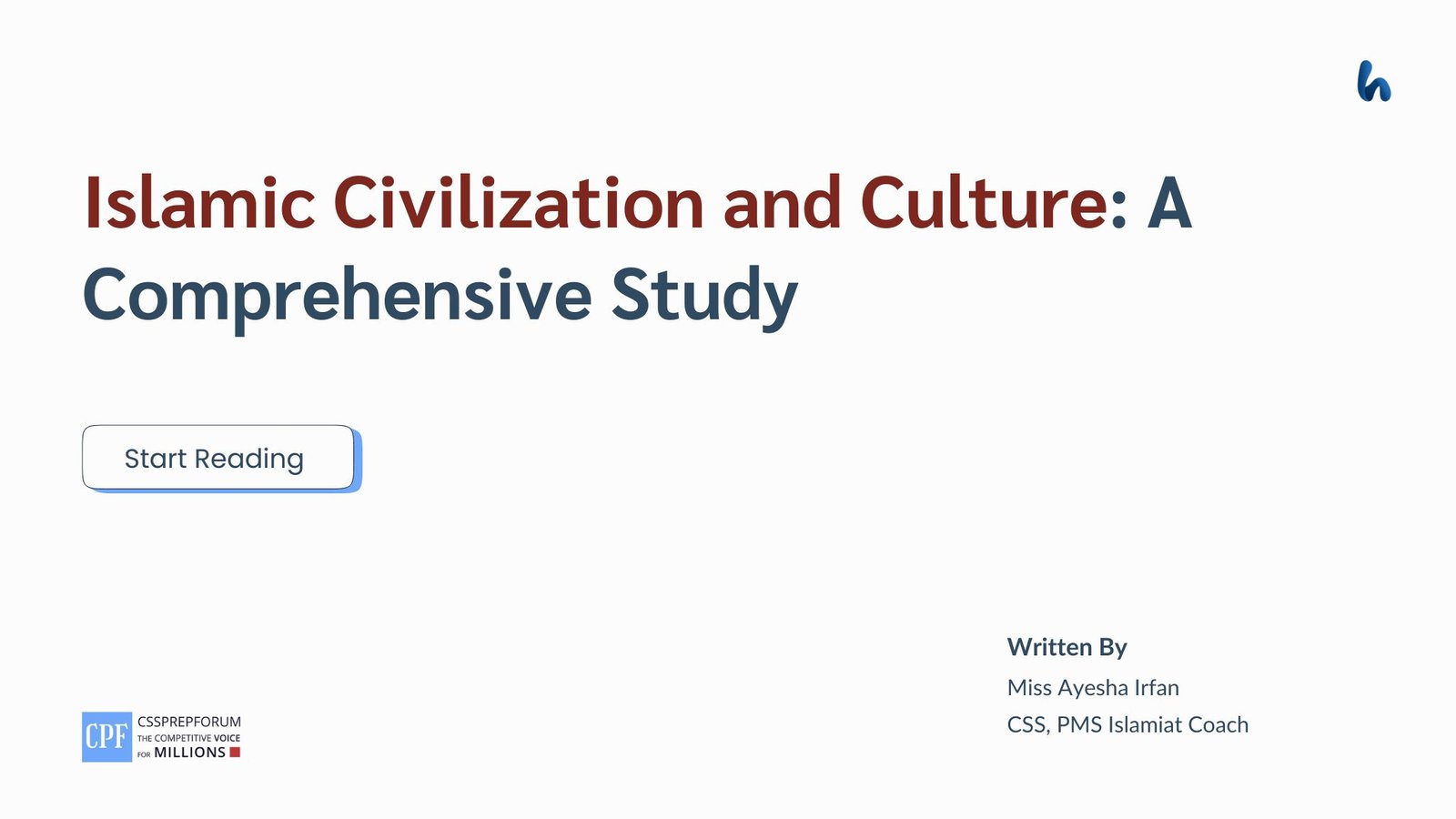The CSS Solved General Science & Ability (GSA) Past Paper 2025 is Solved by Pakistan’s top GSA Coaches, Miss Iqra Ali and Sir Ammar Hashmi. They are the only coaches available in Pakistan who have solved the last 20 years’ GSA solved papers to help aspirants know how to attempt the paper to score above 80. And they have guided thousands of CSS and PMS aspirants. Both coaches have been known for their teaching methodology and imparting concepts to their students, who scored the highest marks in this subject. At the special request of CSSPrepForum, both coaches have solved the paper.

PART-II
SECTION-I
Question No. 2
(A) What effects are produced due to the Rotation & Revolution of Earth? Explain briefly
Question Breakdown:
In this question, the examiner has asked you to explain the effects produced by the rotation and revolution of Earth. To answer this, split the question into two parts, with the first part addressing the effects of rotation and the second part addressing the effects of revolution. Draw diagrams for them separately. Remember, do not over-write; stay to the point and clear in your answers.
Answer:
Rotation and revolution are the phenomena associated with celestial objects. Likewise, these phenomena are also linked with Earth. To understand the effects of Earth’s rotation and revolution, first, a brief understanding of these phenomena is important.
Rotation of Earth:
A rotation is the earth’s movement around its axis, usually called the axis of rotation. The axis of rotation passes through the centre of mass of the earth. It is a synonym for spinning.
Effects Produced due to the Rotation of earth:
The spinning of the Earth around its axis is called rotation. The Earth rotates from West to East (counter-clockwise), and the axis is tilted at 23.5o. The rotation of the Earth causes the occurrence of day and night. It is also responsible for the occurrence of tides in the ocean. The portion of the Earth’s surface that faces the Sun will have a day, and the other parts will have night. The Earth takes about 23 hours, 56 minutes, and 4 seconds to complete its one rotation.

Revolution of Earth:
Revolution of the earth means the movement of the earth around the Sun. It is referred to the orbital motion of an object.
Effects Produced due to the Revolution of the earth:
The movement of the Earth around the Sun in a fixed path is called revolution. It revolves in an elliptical orbit from west to east, i.e., in the anticlockwise direction. And it is responsible for the occurrence of seasons like summer, winter, etc. During the motion, the distance between the Earth and the Sun changes, causing variations in weather. It takes about 365.25 days to complete one revolution around the Sun. The speed of the Earth is about 30km/sec while moving around the Sun.

The same question was asked in CSS General Science and Ability 2017, Question no. 4 (C). You can also go through it to grasp the topic in more depth
(B) Describe Electromagnetic Radiation; give its types and explain their applications.
Question Breakdown:
The question is split into two parts. In the first part, the examiner has asked you to explain electromagnetic radiation. In the next part, he demands types, giving along the applications of all the types. You can draw a minimal flow chart relevant to the answer. Although you are supposed to write an answer per the requirements, here, the answer is attempted in a bit of detail to help students learn it. Remember, writing extra content is not what assures you good marks, but the presentation makes your answer paper stand out among thousands.
Answer:
Electromagnetic Radiations
Electromagnetic radiations are transverse waves in which the electric and magnetic fields are perpendicular to each other and to the direction of propagation of the wave.
Types and Application of Different Electromagnetic Waves
Depending on the oscillation frequency, different wavelengths of the electromagnetic spectrum, from gamma rays to radio waves, are produced.

Ultraviolet Radiations
- Ultraviolet radiations are used in energy-efficient lights, in which fluorescent substances absorb UV light produced inside the lamp and re-emit the energy as visible light.
- UV radiations are also used on bank notes to detect forgeries and allow investigators and forensic researchers to examine clues and recover evidence by providing more detail and contrast to the suspected area than standard lighting techniques.
Infrared Radiations
- In medicine, infrared radiations can promote local blood circulation through their heating effect and reduce muscle tension, thus used in treating autoimmune diseases or wound-healing disorders.
- In homes, infrared radiations are used by electrical heaters and to cook food, as well as short-range communications like remote controls, optical fibres, security systems, and thermal imaging security cameras that detect people in the dark.
Microwave Radiations
- Microwaves are used in domestic and commercial microwave ovens for heating and cooking food. The magnetron present in the internal circuitry of the microwave oven emits microwaves that reflect on striking a metallic surface and are absorbed by the food particles, resulting in heat.
- These are used in various communication techniques, such as satellite communication, cellular communication, optical communication, point-to-point communication, wireless communication, etc.
Radio waves
- Radio waves, with their longest wavelengths, transmit data from radios, televisions, satellites, and RADAR.
- Cellular mobile phones use radio waves to transmit voice communication.
X-rays
- In medicine, X-rays diagnose fractures of bones, foreign bodies like bullets and stones in the body, and dental pathologies. Moreover, these are also used to treat certain types of cancer.
- In the industry, X-rays are used to test the homogeneity of welded joints and detect the structural defects of inaccessible machinery parts.
Gamma-rays
- It helps to kill carcinogenic cells. It also helps to prevent their growth.
- In the industry, radiation checks oil pipelines to detect weak points. Gamma radiation can detect cracks according to variations in thickness. It can also detect density change, weld defect, and non-uniformity of material.
(C) What are Hurricanes? How they are formed and what level of damage they can produce?
Question Breakdown:
This question rationally contains three parts. The first part simply requires a basic understanding of hurricanes. In the second part, you are required to explain the phenomenon of the production of hurricanes, and in the third part, the level of damage to be produced by them. So, address three parts separately. Remember, writing too much can never help you get maximum marks; however, what helps you get good marks is your presentation.
Answer:
Define Hurricanes
A hurricane is a weather phenomenon that is essentially a rapidly rotating storm system with characteristics such as a defined, low-pressure centre, strong winds, and thunderstorms that produce heavy rain. It is generally produced with maximum winds of 74 mph (64 knots) or greater. Hurricanes are also known as tropical cyclones, typhoons, cyclonic storms, tropical depressions, or simply cyclones. The name depends on the storm’s location.
Formation of Hurricane
Hurricanes begin when a tropical depression forms in the ocean. A tropical depression is a line of rain showers and weak thunderstorms that circle around an area of low air pressure. If the water is at least 79°F, a hurricane might form. The low air pressure causes the hot, humid air from the ocean to rise in a spiral shape. As that warm air rises, it releases heat, cools down, and condenses into gusty bands of clouds and storms. The low-pressure area continues to suck up hot, moist air, and the spiral gets stronger and faster.
When winds reach 39 miles an hour, the tropical depression becomes a tropical storm. When winds reach 74 miles an hour, it’s officially a hurricane. As a hurricane moves over cooler water or hits land, it loses the warm water that fuels it and begins to weaken. But dangerous winds can still cause damage, and storm surges can flood coastal areas with more than 20 feet of water. Heavy rains and floods can continue far inland.

Damage Produced by Hurricanes
Following are the impacts of cyclones/hurricanes.
- Damage produced by Hurricanes Winds
High winds can rip the roof of a house or destroy it entirely, destroy buildings, collapse weak structures, and snap or uproot trees. It can also result in power outages. - Damage produced by Storm surge
Storm surge can cause massive destruction along the coast, including beach and dune erosion, road and bridge damage, and loss of life. Also, it can travel inland, causing devastating flooding.g - Damage produced by the Hurricanes associated torrential rain
Hurricanes can cause widespread torrential rains that can lead to flooding, landslides and mudslides hundreds of miles from its source - Damage produced by the Flying debris
Moving or airborne debris can break windows and doors, allowing high winds and rain inside. - Post-Hurricane Impacts – Public health and psychology
Hurricanes can cause long-term health issues such as post-traumatic stress disorder, negatively affect reproductive health, and increase exposure to infectious and noninfectious diseases. Moreover, after a hurricane has struck and the strong winds and flooding have subsided, people start to return to their houses to inspect the damage. Often, the damage they find is devastating as almost everything is destroyed, and thousands of people are left homeless, leaving fear among the masses.
The same question was asked a little differently in CSS General Science and Ability paper 2019, Question no. 3 (C) and CSS General Science and Ability paper 2020, Question no. 5 (B). You can also go through them to grasp the topic in more depth
(D) Explain the advantages and disadvantages of nitrogen containing fertilizers and insecticides
Question Breakdown:
The examiner has asked you to explain the advantages and disadvantages of nitrogen containing fertilizers and insecticides. So, split the question into two parts after defining the key term, I.e., Nitrogenous fertilizers: first part as advantages and second as disadvantages. No diagram is required in this question. You can add both in bullets too.
Answer:
Nitrogenous fertilizers are one of the chemical fertilizers that add nitrogen to soil. They can be used in the form of a gas or liquid and after a certain period these are converted into salts (ammonium sulfate, ammonium phosphate, and ammonium nitrate). Likewise, Nitrogenous insecticides are chemicals containing nitrogen that are used in crops to kill insects.
Advantages of Nitrogen containing Fertilizer and Insecticides
- Nitrogen can increase crop yields and protein content by encouraging the development of foliage. In case of cereals, it tends to produce lumpiness in seeds, and it tends to produce succulence or tenderness in the plant.
- Nitrogen fertilizers and insecticides can help maintain soil fertility and structure, and improve water retention.
- Nitrogenous fertilizers imparts green color to leaves and shoots of the plants that otherwise acquire a light green and yellow color and die off early.
- Nitrogen plays a key-role in increasing crop resilience by nourishing their growth and health.
- Natural nitrogen fertilizers can help avoid over-fertilization and promote sustainable farming practices.
- Nitrogen fertilizers can provide nutrients to plants gradually and improve the quality of crops.
Disadvantages of Nitrogen containing Fertilizer and Insecticides
- Along with killing insects, excess nitrogen kills small roots and makes plants more susceptible to root decay and nematodes.
- When extra nitrogen in insecticides and fertilizers seeps down to the ground water or enter water ways contaminates them with nitrates, not only hampering the quality of water for drinking but also being hazardous for the aquatic life.
- Likewise, it can make soil more acidic and less fertile by harming soil microbes and natural material
- Nitrogenous fertilizers and insecticides can be responsible for causing algae blooms, which can decrease oxygen levels in water and kill fish and other aquatic organisms.
- Last but not least, too much nitrogen can burn plants and reduce crop yield.

Question No. 3
(A) Explain how temperature and light intensity affect the rate of photosynthesis in plants
Question Breakdown:
The examiner, in this question, is has asked you to explain the impact of temperature and light intensity on the rate of photosynthesis. So, for this, start your answer with defining photosynthesis and then moving the next part by splitting it further, addressing the role of light and temperature individually. Remember, being creative is what will award you maximum marks in your GSA paper.
Answer:
Define Photosynthesis:
Photosynthesis is a process through which green plants and certain other organisms transform Co2 and water with the help of light energy into energy-rich organic compounds and O2.

Effect of Temperature and Light Intensity On Photosynthesis
- Effect of Temperature
The chemical reactions that combine carbon dioxide and water to produce glucose are controlled by enzymes, and temperature plays a key role in propagating or limiting such reactions. As with any other enzyme-controlled reaction, the rate of photosynthesis is affected by temperature.
At low temperatures, the rate of photosynthesis is limited by the number of collisions between enzymes and substrate. As temperature increases the number of collisions increases, therefore the rate of photosynthesis increases. However, at high temperatures, enzymes are denatured and this will decrease the rate of photosynthesis. The optimum temperature for most plants is 15°C to around 40°C.

- Effect of Light Intensity
Light/ sunlight are prerequisites for photosynthesis reaction. Even if there is plenty of water and carbon dioxide, plants cannot photosynthesize in the absence of light. Thus, the intensity of light varies directly and linearly with the rate of photosynthesis until some other factor – a limiting factor – becomes in short supply.

However, at very high light intensities, photosynthesis is slowed, but these light intensities do not occur in nature.
(B) Describe the structure and functions of capillaries in the human blood circulatory system.
Question Breakdown:
This question has basically two parts. While answering the question, you need to. Remember, writing too much can never help you get maximum marks; presentation is what helps your papers stand out among thousands.
Answer:
What are Capillaries?
Capillaries are the smallest and most numerous blood vessels in the body, characterized by extremely thin walls composed of a single layer of endothelial cells connecting arterioles (small arteries) to venules (small veins). These have mixed oxygenated and deoxygenated blood.
Structure of Capillaries
Capillaries are the tiniest blood vessels in the body, forming the crucial connection between the smallest arteries, called arterioles, and the smallest veins, called venules. They create an extensive network, with about 40 billion capillaries in the average human body, ensuring that every cell is close to a blood supply. Capillaries are extremely thin, measuring only about 5 micrometres in diameter, which is so narrow that red blood cells must pass through them in a single file. Their walls are made up of just two layers of cells: a single layer of endothelial cells and an outer layer of protein called the basement membrane. This thin and simple structure allows capillaries to efficiently exchange oxygen, nutrients, and waste products between the blood and surrounding tissues. Their design is perfectly suited for their role as the primary sites of material exchange in the circulatory system.
Function of Capillaries
- Capillaries facilitate the exchange of oxygen and carbon dioxide between the blood and tissues through diffusion across their thin walls.
- They transport essential nutrients, such as glucose and amino acids, from the blood to the body’s cells.
- Capillaries collect metabolic waste products, such as carbon dioxide and urea, from tissues and transport them back into the bloodstream for elimination.
- They regulate the movement of fluid between the blood and interstitial fluid (extracellular fluid) based on pressure gradients, maintaining fluid balance in the body.
- The diameter of capillaries can be altered by nervous stimulation or chemical signals (e.g., histamine), controlling the amount of blood flow to specific tissues. Precapillary sphincters further regulate blood flow into capillary beds.
(C) What is hepatitis? Give its types and briefly explain its common symptoms along with preventions
Question Breakdown:
The question has three parts. In the first part of this question, the examiner has asked you to explain about hepatitis. So, write down its definition with a general description of types in table form. When done, move towards the next part and write down the symptoms associated with hepatitis in bullets. Finally, write down all the possible preventive measures in bullet points. You can also address this question in the table form.
Answer:
Hepatitis
Hepatitis, the inflammation of the liver, is a viral disease. However, sometimes medication, drugs, toxins, and alcohol are also responsible for autoimmune hepatitis disease that occurs when a human body makes antibodies against liver tissues. Some of the common symptoms of hepatitis are fatigue, loss of appetite, high fever, nausea, vomiting and abdominal pain.
Types of Hepatitis
Hepatitis is mainly classified into five categories: Hepatitis A, Hepatitis B, Hepatitis C, Hepatitis D, and Hepatitis E, among which the first three are better known.
| Hepatitis A | Caused by a non-enveloped RNA virus |
| Hepatitis B | Caused by a DNA virus |
| Hepatitis C | Caused by RNA enveloped virus |
| Hepatitis D | Caused by a defective RNA virus (requires Hepatitis B virus for replication) |
| Hepatitis E | Caused by a non-enveloped RNA virus |
Common Symptoms of Hepatitis
- Fatigue
- Nausea and vomiting
- Frequent Fever
- Abdominal pain, especially in the upper right side
- Loss of appetite
- Jaundice (yellowing of the skin and eyes)
- Dark urine
- Joint aches
Preventive Measures to Avoid Hepatitis
Vaccines are available for hepatitis A and B. Hepatitis B vaccination is recommended for all infants and high-risk individuals. There is no vaccine for hepatitis C, D, or E. Other than that, maintaining good hygiene, ensuring the drinking of safe drinking water, practising safe sexual activities, and staying away from using contaminated needles and blood products are necessary to prevent hepatitis.
(D) Differentiate between biomass and biogas. Briefly explain various methods for obtaining energy from biomass.
Question Breakdown:
In the first part of this question, the examiner has again asked you two questions. First is differentiating biomass and biogas. To answer it, make a table of differences. In the next part, explain the methods of obtaining energy from biomass. For the answer, two methods would be enough, but here answer three are explained to increase clarity for aspirants.
Answer:
| Biomass | Biogas |
| Biomass refers to organic materials, such as wood, crop residues, and animal waste, that can be used as fuel. | Biogas is a type of gas produced from the anaerobic digestion of organic materials like food waste, animal manure, or sewage. |
| Biomass is typically in solid form, and its energy content can be used for heating, electricity generation, or fuel. | Biogas is a gaseous fuel primarily composed of methane and carbon dioxide, which can be used for heating, electricity generation, or as vehicle fuel. |
| Biomass comes from plant-based and animal-based organic materials, which can be processed in various ways. | Biogas is produced by microorganisms breaking down organic waste in the absence of oxygen, typically in a controlled biogas digester. |
| Biomass energy is obtained through direct combustion, gasification, fermentation, or pyrolysis processes. | Biogas energy is obtained through the process of anaerobic digestion, where organic waste breaks down in a sealed environment. |
| Biomass can be used for a variety of applications, including heating homes, generating electricity, and producing biofuels like ethanol and biodiesel. | Biogas is primarily used for generating electricity and providing heating, and can also be converted to vehicle fuel. |
| Biomass, when burned, can produce emissions, but it is considered a renewable energy source due to its organic nature. | Biogas is considered environmentally friendly, as it produces fewer harmful emissions compared to fossil fuels. |
Question No. 4
(A) What is deforestation? State the disadvantages caused to the environment due to this?
Question Breakdown:
The question contains two parts. The first part demands the meaning of deforestation, and in the second part, the negative impacts of deforestation on the environment are asked. Now, this might not demand equal division in weightage while answering as rationally, the second part demands more information than the first. You can write the disadvantages in bullet form to make it simpler and organized.
Answer:
Define Deforestation
Deforestation is the purposeful clearing or thinning of forested land by human actions to make space for agriculture and animal grazing, and to obtain wood for fuel, manufacturing, and construction.
Disadvantages Caused by the Environment due to Deforestation
- Increase in Carbon Dioxide Levels (Impact on Atmosphere)
Trees are about 50% carbon, and when they are removed for burning, the carbon stored in them is released as carbon dioxide (CO₂), a major greenhouse gas. Moreover, they are natural sequestrators, sinking global carbon and keeping the balance. With increased deforestation, the carbon sink vanishes, leading to the accumulation of CO2 in the environment, thus causing global warming.
- Disruption of the Water Cycle
Forests play a key role in maintaining the water cycle by releasing moisture into the atmosphere through evaporation and helping water infiltrate the soil through their roots. Without trees, less water evaporates, causing drier climates, more runoff, and increased flooding
- Soil Degradation
Forests support healthy soil through the natural return of organic matter. More immediately, the loss of trees from a forest can leave soil more prone to erosion. This causes the remaining plants to become more vulnerable to fire as the forest shifts from being a closed, moist environment to an open, dry one.
- Loss of Biodiversity
Deforestation also threatens the world’s biodiversity. Tropical forests are home to great numbers of animal and plant species. When forests are logged or burned, it can drive many of those species into extinction. Some scientists say we are already in the midst of a mass-extinction episode.
(B) Explain how water pollution is produced? Describe the part played by bacteria after a river has been polluted by sewage.
Question Breakdown:
In the first part of the question, the examiner has asked you to write about the process of water pollution. Moreover, in the second part of the question, the examiner wants you to explain the role of bacteria coming from sewage in causing water pollution. Start your answer with the definition of water pollution, then come to the main answer. Keep in mind not to write too much in your GSA paper since the question contains no more than five marks. The more parts of the question become, the less they get their weightage. Hence, your question must be concise and complete at the same time
Answer:
Define Water Pollution
Any change in the physical and chemical properties of water that makes it unsuitable for drinking and other purposes.
How is water pollution produced?
Water pollution occurs when harmful substances are introduced into natural water bodies, disrupting their chemical and biological balance. This contamination can come from several sources, including untreated domestic sewage, industrial effluents, agricultural runoff containing fertilizers and pesticides, and even accidental oil spills. When these pollutants enter rivers, lakes, or oceans, they alter the physical and chemical properties of the water. For example, the pH may change, heavy metals may accumulate, and excessive nutrients like nitrates and phosphates can promote the rapid growth of algae, called eutrophication. These changes often reduce the level of dissolved oxygen, interfere with aquatic life, and make water unsafe for human use.
Role of bacteria from Sewage as the cause of water pollution
When a river is polluted by sewage, that is the waste from humans, bacteria plays a significant role by rapidly multiplying due to the following reasons.
- 1- First, naturally occurring aerobic bacteria (those that need oxygen) begin to break down the organic matter in the sewage. This is a biological oxidation process, similar to combustion but slower and enzyme-driven.
- 2- As bacteria decompose the sewage, they consume a lot of dissolved oxygen (DO) from the water. This is measured as the biological oxygen demand (BOD).
- 3- If the sewage is heavy and the river flow is slow, oxygen gets depleted rapidly. Low oxygen levels can kill fish and other aquatic life that depend on oxygen.
- 4- If oxygen runs out, anaerobic bacteria take over. These bacteria don’t need oxygen, but they produce toxic gases like methane (CH₄) and hydrogen sulfide (H₂S), which further pollute the water and create foul smells.
(C) State some examples of pollution caused by human activity and discuss the effects of each example
Question Breakdown:
In the first part of the question, the examiner has asked you to comprehensively explain examples of pollution causes with the effects of each separately. Since these two parts are to be solved collectively, break down the question accordingly. Take five examples and write the effects under each. You can make a table too if it does not hamper the presentation. Keep in mind not to write too much in your GSA paper since the question contains no more than five marks; thus, write accordingly.
Answer:
Define Pollution
Pollution is the introduction of harmful substances or energy into the environment, such as air, water, or land, in quantities that cause adverse changes to living organisms and ecosystems.
Examples of Pollution Caused by Human Activity and Effects
| Overuse of pesticides and chemical fertilisers in farming | Human Activity Causing Pollution | Effects of Pollution |
| Air Pollution | Burning fossil fuels in vehicles and factories | – Increases asthma and lung diseases in urban populations. – Accelerates global warming due to CO₂ emissions. |
| Water Pollution | Discharge of industrial waste and sewage into rivers | – Kills fish and disrupts aquatic ecosystems. – Contaminates drinking water sources, leading to disease outbreaks. |
| Soil Pollution | Overuse of pesticides and chemical fertilizers in farming | – Reduces soil fertility, lowering crop yields. – Toxic residues enter food chains, harming human health. |
| Plastic Pollution | Improper disposal of plastic products | – Marine animals ingest plastic, leading to injury or death. – Microplastics contaminate seafood consumed by humans |
| Thermal Pollution | Release of hot water from power plants into rivers | – Decreases oxygen levels in water, killing sensitive fish species. – Disrupts local aquatic biodiversity. |
| Noise Pollution | Heavy traffic, construction, and industrial machines | – Causes hearing loss and high stress levels in city dwellers. – Disorients wildlife, especially birds and marine life. |
| Light Pollution | Excessive outdoor lighting in cities | – Affects sleep patterns in humans due to melatonin disruption. – Interferes with migration and reproduction in nocturnal animals. |
| Oil Pollution | Oil spills from tankers and offshore drilling | – Destroys marine habitats and kills seabirds and fish. – Long-lasting contamination of coastal ecosystems. |
| Radioactive Pollution | Improper disposal of nuclear waste or accidents (e.g. Chernobyl) | – Causes genetic mutations and cancers in affected populations. – Leaves the land uninhabitable for decades. |
(D) What does air pollution mean? State ten serious effects of air pollution on the environment and briefly explain how they can be reduced?
Question Breakdown:
The question consists of three parts. In the first part, you are supposed to define Air Pollution. Then in the second part, the examiner has asked you to explain ten serious effects of air pollution on the environment. Since effects are ten for a maximum of two marks, only write them in bullets to avoid overdoing. In the end, give suggestions, again in bullets, to reduce the effects of air pollution. Keep in mind, when reducing the impacts are asked, it means the examiner is particularly asking for adaptation measures and not the mitigation measures. The answers here are still more than necessary, only for the ease of the students. Students must know how much the examiner is asking and answer accordingly.
Answer
Define Air Pollution
Air pollution happens when the composition of the air changes, whether it’s in terms of volume or alterations in its chemical, physical, or biological characteristics. The atmosphere consists of a delicate equilibrium of elements and particles, and any disruption, no matter how slight, can have harmful effects on living organisms, such as animals and crops.
According to the World Health Organization (WHO),
“Air pollution is contamination of the indoor or outdoor environment by any chemical, physical or biological agent that modifies the natural characteristics of the atmosphere.”
Ten Serious Effects of Air Pollution on the Environment
A- Effects on the Natural Environment
- Acid rain caused by air pollution degrades landforms and affects natural landscapes, such as mountains and valleys.
- Air pollution damages plant leaves, disrupts photosynthesis, and reduces crop yield and forest health.
- It leads to habitat degradation, endangering wildlife and altering ecosystem balance.
- Soil contamination from airborne pollutants reduces fertility and harms microorganisms vital to soil health.
- Airborne chemicals and particulates pollute water and degrade air quality, affecting life and natural cycles.
B- Effects on the Manmade Environment
- Acid rain corrodes buildings, bridges, and monuments, especially those made from stone or metal.
- Smog and particulate pollution reduce visibility and cause deterioration of urban infrastructure.
- Air pollution negatively affects public health, causing respiratory problems, particularly in vulnerable populations.
- Polluted environments can strain social and community relations, especially in areas facing environmental injustice.
- Greenhouse gas emissions from air pollution contribute to global warming and climate instability.
Ways to Reduce the Effects of Air Pollution
The following are some ways humans can use to reduce the effects of air pollution on them
- Wear protective masks in high-pollution areas to reduce inhalation of harmful particles.
- Install air purifiers in homes, schools, and hospitals to improve indoor air quality.
- Create green buffer zones around cities to shield populations from pollutants
- Design buildings with proper ventilation to reduce indoor exposure
- Issue public health advisories on high-pollution days to protect vulnerable groups.
Question No. 5
(A) Differentiate between food contaminants and food adulterants.
Question Breakdown:
In this question, the examiner has simply asked you to differentiate food contaminants and food adulterants. Simply draw a table of differences to give a comprehensive and to-the-point, relevant answer. Do not write too much because how you present only the aspects asked in your exam ensures your success, and not the length in the GSA paper.
Answer
| Food Contaminants | Food Adulterants |
| Food contaminants are unintended substances that enter food during production, processing, or handling, often due to environmental factors or poor hygiene. | Food adulterants are intentionally added substances used to increase profit by altering the quality or quantity of food products. |
| Contamination is usually accidental and occurs without the intent to deceive, often resulting from negligence or environmental exposure. | Adulteration is an activity aimed at deceiving consumers, often by adding inferior or harmful substances to food. |
| Examples of food contaminants include pesticide residues, heavy metals, microbial toxins, and chemical residues from packaging materials. | Examples of food adulterants include adding water to milk, mixing brick powder in chilli powder, or using synthetic dyes in turmeric. |
| Contaminants can enter food through environmental pollution, improper storage, or unsanitary processing conditions. | Adulterants are added to food products intentionally to increase volume, weight, or appearance, often compromising safety. |
| The presence of contaminants is often due to a lack of proper quality control and can occur at any stage from farm to table. | Adulteration is driven by economic motives, aiming to reduce production costs or increase profits at the expense of consumer health. |
(B) Enlist major food groups based on nutrients, their functions and sources
Question Breakdown:
The question has three sections. In the first section, the examiner has asked you to enlist major food groups based on nutrients. In the second section, the functions of those nutrients are asked, and in the third section, the examiner asks about the sources of nutrients. You can either solve this question wit each section saperately or draw a table for it.
Answer:
Food Groups:
Food groups are categories used to organize foods based on their similar nutritional characteristics or biological classifications.
Food Groups based on Nutrients:
Food groups can be broadly classified based on the nutrients they provide. These groups with their functions and sources are given below.
| Nutrients | Functions | Sources |
| Carbohydrates | Carbohydrates are the most abundant biomolecule on earth and serve as the primary source of energy. Glucose is added into the bloodstream to provide energy to the body. | Cereals, grains, vegetables, dairy products |
| Proteins | Proteins are vital for making protoplasm in cells and are responsible for the production of enzymes, hormones, and antibodies. They are essential for pregnant women to maintain the growth of children. | Meat, fish, eggs, legumes, dairy products, soy products |
| Lipids | Lipids, composed of fatty acids, glycerol, and sterol, are water-insoluble and energy-rich. They are crucial for the formation of brain cells, cell membranes, and steroids. | Oils, butter, nuts, seeds, fatty fish, dairy |
| Vitamins | Vitamins are organic compounds essential for body growth. They enhance the absorption of nutrients and play a role in blood cell and DNA production. | Fruits, vegetables, dairy, whole grains, meat, fish |
| Minerals | Minerals are vital for the body’s proper growth and cannot be synthesised internally, requiring daily intake. | Leafy greens, dairy, nuts, seeds, meat, fruits |
(C) What is Artificial Intelligence and how does it differ from traditional programming? Describe the main branches of Artificial Intelligence.
Question Breakdown:
This question also contains three parts. In the first part, you are supposed to define artificial intelligence in your own words. In the second part, the difference between Artificial Intelligence and traditional programming is asked, and in the last part, the examiner has asked you to describe the main branches of AI. Remember, writing too much can never assure you the maximum marks; the presentation of your paper is what matters.
Answer:
Define Artificial Intelligence:
Artificial intelligence refers to computer systems capable of performing tasks that are typically thought to require human intelligence. The term Artificial Intelligence was coined by John McCarthy in 1956 at the Dartmouth conference, Massachusetts Institute of Technology (MIT).
Example:
WABOT-2, a robot developed by Wasefa University in Japan in the 1980s, utilized AI programs to play a keyboard instruments, red sheet music, and converse rudimentarily with people.
Difference between Artificial Intelligence and Traditional Learning
| Artificial Intelligence | Traditional Programming |
| AI programming particularly machine learning (ML) works differently from traditional programming. Instead of relying on explicitly defined rules AI models learn from data and make decisions based on patterns. In AI the programmer does not explicitly define every possible rule. Instead, the system is trained on large amounts of data and learns to make decisions based on data. | Traditional programming follows a rule-based approach, meaning the programmer writes explicit instructions that the computer follows step by step. This method works well when the rules and logic for solving a problem are clearly defined. In this the developer specifies what needs to be done and how it should be done. The program takes an input, processes it using predefined rules and produces a predictable output. |
| For Example, If an AI system is trained to recognize spam emails, it analyzes thousands of examples of spam and non-spam emails. Over time, it identifies common characteristics of spam emails, such as specific words or phrases and learns to classify new emails accordingly, even those it has never seen before. | For Example, If you are building a calculator, you will need to define exact rules for how addition, subtraction, multiplication and division work. The computer does not “think” or “learn”, it simply executes the instructions given by the programmer. |
| AI systems can adapt and improve their performance over time based on experience or new data. | Traditional programs do not learn from experience and behave the same way unless manually updated. |
| AI can handle complex, uncertain, and unstructured data such as images, speech, or natural language. | Traditional programming requires clear, structured, and well-defined inputs to function correctly. |
| AI is suitable for tasks like pattern recognition, natural language processing, and autonomous decision-making. | Traditional programming is best suited for repetitive, logical, and rule-based tasks like calculations. |
| In AI, the focus is on creating models that generalize well from data rather than following fixed rules. For example, an AI spam filter detects new spam patterns without needing rule updates. | In traditional programming, the logic and rules must be explicitly written and handled by the programmer. For example, a payroll system uses fixed formulas set in code. |
Main branches of Artificial Intelligence
(D) What are the advantages of optical fibers in communication system? Draw basic structure of optical fiber and explain propagation of light through it.
Question Breakdown:
In the first part of question, the examiner has first asked you to explain the advantages of optical fibers in communication system. Then, it is asked to draw basic scructure of optical fiber and in the end, explain propagation of light through it. So write step wise by initiating with the definition of optical fibers. Keep in mind not to write too much in your GSA paper since the question contains no more than five marks. The more the parts of question become, the less get their weightage. Hence, your question must be concise and complete at the same time. In this attempt, the questions attempted are relatively detailed so that student may learn it thoroughly.
Answer:
Define Optical Fiber:
Fiber optics is a bundle of thin strands made of glass or plastic, which uses light (photon particles) to transmit signals. Therefore, the transmission capacity of fiber optic is far greater than other modes of communication, such as copper wire and metallic wires. As a result, it is used in the form of different cables and is being utilized in numerous fields of life.
Advantages of Optical Fibers in Communication System
- Optical fibers can transmit vast amounts of data at extremely high speeds, making them ideal for modern internet and communication demands.
- Due to their low signal attenuation, optical fibers can carry data over long distances without significant loss, reducing the need for signal boosters.
- Unlike copper cables, optical fibers are not affected by electromagnetic interference, ensuring a more stable and reliable connection.
- Optical fiber cables are difficult to tap into without detection, providing a higher level of data security for sensitive communications.
- Optical fibers are lighter and more durable than traditional metal wires, making installation easier and reducing maintenance costs
Basic structure of Optical Fibers
Optical fiber consist of four layers
- Core made up from glass
- Cladding is a reflective layer made up from glass or plastic
- Coating cover as a protective layer
- Jacket to bundle all fibers in one cable.
There are many types of optical fibers. However, the most significant types are single-mode optical fiber( a fiber that is designed for carry a single signal at a time) and multi-mode optical fiber (a fiber that is designed to carry more than one signal at a time).
Process of Propagation of Light through Optical Fiber:
The propagation of light in an optical fiber requires that light should be totally confined within the fiber and not escape from it. This can be done by
- Total internal reflection
- continuous Refraction
In a fiber-optic system, a machine called a transmitter turns information into light. Then the transmitter sends the light through optical fibers. As the light moves at a high speed through the core, it bounces off the cladding either by the phenomenon of total internal reflection or continuous refraction. If the fiber has a bend in it, the light can bounce off the cladding and turn the corner to follow the bend. At the end of the fibers, a machine called a receiver accepts the light. The receiver turns the light back into sound, pictures, or computer codes.
SECTION-II
Question No. 6
(A) In an annual sale, Saima buys a fridge and a freezer. The sale offers 15% off everything and she pays a total of Rs. 57,120. If the price of a freezer before the sale is Rs. 40,000. What was the price of the fridge before the sale?
Answer:
Given data
- The original price of the freezer = Rs. 40,000
- The original price of the fridge = X
- The discount offered = 15% off on both items
Step 1: Compute the discounted prices
Since the discount is 15%, the price after the discount for any item is:
Discounted Price = Original Price x (1 – 0.15)
For the freezer:
Discounted Price of Freezer = 40,000 x 0.85 = 34,000
For the fridge:
Discounted Price of Fridge = (X) x 0.85 = 0.85X
Step 2: Form the equation
According to the problem, the total price Saima paid after the discount is Rs. 57,120
34,000 + 0.85X = 57,120
Step 3: Solve for X
0.85X = 57,120 – 34,000
0.85X = 23,120
X = 32,120/0.85
X = 27,200
Final Answer
The original price of the fridge before the sale was Rs. 27,200.
(B) Mr Rasheed pays a deposit of Rs. 60,000, followed by 36 equal monthly payments. The total amount that he pays is 127% of the basic price of Rs. 3,360,000. Calculate Rasheed’s monthly payment.
Answer
Given data
- Basic price = Rs. 3,360,000
- Total amount paid = 127% of the basic price
- Deposit paid = Rs. 60,000
- Number of monthly payments = 36
Step 1: Calculate the Total Amount Paid
Total Amount Paid = 127% × 3,360,000
= 127/100 × 3,360,000
= Rs. 4,267,200
Step 2: Determine the Remaining Amount
Remaining Amount = Total Amount Paid – Deposit
= 4,267,200 – 60,000
= Rs. 4,207,200
Step 3: Calculate the Monthly Payment
Monthly payment = Remaining amount/Number of months
= 4,207,200/36
= 116,866.67
Final Answer:
Mr Rasheed’s monthly payment is Rs. 116,866.67.
(C) Divide Rs. 600 among A,B, and C so that Rs. 40 more than 2/5 of A’s share, Rs. 20 more than 2/7 of B’s share and Rs. 10 more than 9/17 of C’s share may be equal.
Answer
Let
- A’s share as x
- B’s share as y
- C’s share as z
The total amount to be divided:
x + y + z = 600
According to the given conditions:
- Rs. 40 more than 2/5 of A’s share is equal to the common value
2/5 x + 40 = k
- Rs. 20 more than 2/7 of B’s share is equal to the same value:
2/7 y+ 20 = k
- Rs. 10 more than 9/17 of C’s share is equal to the same value:
9/17 z+ 10 = k
Step 1: Express x,y,z in terms of k

Step 2: Solve for k
Since the total sum is 600:
x + y + z = 600
(5/2)(k-40) + (7/2)(k-20) + (17/9)(k-10) = 600
Taking the LCM of denominators, which comes out to 18, thus multiplying by 18 on both sides
18 x {5(k-40) + 7(k-20) + 17(k-10)} = 18 x 600
45(k-40) + 163(k-20) + 34(k-10) = 10,800
Expanding:
45k – 1800 + 63k – 1260 + 34k – 340 = 10,800
45k + 63k + 34k = 10,800 + 1800 + 1260 + 340
142k = 14,200
k = 14,200/142
k = 100
Step 3: Compute x,y,z

Final Answer:
A = 150
B = 280
C = 170
(D) Find out the correct words from the jumbled spellings given below.
| Jumbled Words | Correct Words |
| TEANAIRM | MARINATE |
| VAGNACEXETRA | EXTRAVAGANCE |
| VADIELTIONC | VALEDICTION |
| PKUNYBARTC | BANKRUPTCY |
| TAESROSNC | ANCESTORS |
Question No. 7
(A) Calculate the marked price of the sculpture if it is sold for Rs. 79950 after a discount of 18%. On another day, if 10% discount is given on the marked price of the same sculpture before it is sold at a further discount of 8%. Would the sale price still be Rs. 79950?
Answer
Step 1: Calculate the Marked Price
Given data:
- Selling price after 18% discount = Rs. 79,950
- Let the marked price be M
- Discount formula:
Selling Price = Marked Price × (1−Discount Percentage)
79,950 = M x (1 – 0.18)
79,950 = M x 0.82
M = 79,950/0.82
M = Rs. 97,500
Step 2: Check the New Discount Scenario
Now, the same sculpture is given a 10% discount first, followed by an 8% discount.
- First discount of 10% on Marked Price:
Price after first discount = 97,500 x (1 – 0.10)
= 97,500 x 0.90
= 87,750
- Second discount of 8% on the new price:
Final selling price=87,750 × (1−0.08)
= 87,750 x 0.92
= 80,730
Step 3: Compare with Rs. 79,950
- In the first case, the final price was Rs. 79,950.
- In the second case (two-step discount), the final price is Rs. 80,730.
Conclusion
Since Rs. 80,730 ≠ Rs. 79,950, the sale price would not still be Rs. 79,950.
It would be Rs. 80,730 instead.
(B) Majid pays a total of Rs. 51,520 for his car insurance. The total is made of a basic charge plus 15% sales tax. Calculate the amount of sales tax that Majid pays.
Answer
Given data
- Total amount paid = Rs. 51,520
- Sales tax rate = 15%
- Total amount includes the basic charge and the sales tax
Step 1: Let the Basic Charge be x
The total amount paid includes 15% sales tax:
Total amount = x + 0.15x
51,520 = 1.15x
Step 2: Solve for x
x = 51,520/1.15
x = 44,800
Step 3: Calculate the Sales Tax
Sales tax = 0.15 x 44,800
= 6720
Final Answer
Majid pays Rs. 6,720 as sales tax.
(C) A campsite in the shape of a rectangle has sides (3x+6)m and (x+1)m, and the length of the diagonal is (4x+1)m. Find the area and perimeter of the campsite.
Answer
We are given a rectangular campsite with:
Length = (3x+6)m
Width = (x+1)m
Diagonal = (4x+1)m
We need to find the values of x, area, and perimeter.
Step 1: Use the Pythagorean Theorem
Since the campsite is rectangular, the diagonal forms a right triangle with the length and width:
(Length)2 + (Width)2 = (Diagonal)2
(3x+6)2 + (x+1)2 = (4x+1)2
Expanding each term:
(9x2 + 36x + 36) + (x2 +2x +1) = (16x2 + 8x + 1)
10x2 + 38x + 37 = 16x2 + 8x + 1
Step 2: Solve for x
Rearrange the equation:
10x2 – 16x2 + 38x – 8x + 37 – 1 = 0
-6x2 + 30x + 36 = 0
Multiply by −1 to simplify:
6x2 – 30x – 36 = 0
Divide by 6:
x2 – 5x – 6 = 0
Factorize:
(x-6)(x-1) = 0
Thus, x=6 or x=−1. Since length and width cannot be negative, we take:
x = 6
Step 3: Find Length, Width, and Diagonal
Substituting x=6
- Length = 3x + 6 = 3(6) + 6 = 24
- Width = x + 1 = 6 + 1 = 7
- Diagonal = 4x+ 1 = 4(6) + 1 = 25
Step 4: Calculate Area
Area = Length x Width
= 24 x 7= 168 m2
Step 5: Calculate Perimeter
Perimeter = 2(Length + Width)
= 2(24+7)
= 2×31
= 62 m
Final Answer:
- Area = 168 m²
- Perimeter = 62 m
(D) Arrange the following fractions in the descending order.
Answer

Question No. 8
(A) A train, in the first five successive minutes from its start, runs 68m, 127m, 208m, 312m, and 353m and, for the next 5 minutes, maintains an average speed of 33 km/hr. Find the whole distance covered and the average speed in covering this total distance.
Answer
Given data
- Distance covered in the first 5 minutes:
- 1st minute: 68 m
- 2nd minute: 127 m
- 3rd minute: 208 m
- 4th minute: 312 m
- 5th minute: 353 m
- For the next 5 minutes, the train maintains an average speed of 33 km/h.
Step 1: Calculate the Distance Covered in the First 5 Minutes
Total distance in first 5 minutes=68+127+208+312+353 =1068 m
Step 2: Calculate the Distance Covered in the Next 5 Minutes
- Speed = 33 km/h
- Convert speed to meters per minute
33 x (1000/60) = 550m/min
Distance covered in 5 minutes
550 x 5 = 2750 m
Step 3: Find the Total Distance Covered
Total Distance=1068+2750=3818 m or 3.818 km
Step 4: Calculate the Average Speed
Total time=10 minutes=10/60 = 1/6 hours
Average speed = Total distance/Total time
= 3.818 ÷ 1/6
= 3.818 x 6
= 22.91 km/h
Final Answers
- Total distance covered = 3.818 km
- Average speed = 22.91 km/h
(B) A solid cuboid with base 10 cm by 6 cm is available. the height of the cuboid is ‘y’ centimeter and the total surface area of the cuboid is given to be 376 cm2. Find the height of the cuboid.
Answer
Given data
We are given a solid cuboid with:
- Length = 10 cm
- Width = 6 cm
- Height = Y cm
- Total surface area = 376 cm²
Step 1: Surface Area Formula of a Cuboid
The total surface area (TSA) of a cuboid is given by:
Total Surface Area (TSA) = 2(lw + wh + hl) sq. units
Step 2: Substitute the Given Values
376 = 2 (10×6 + 6 x Y + Y x 10)
376 = 2 (60 + 6Y +10Y)
376 = 2 (60 +16Y)
376 = 120 +32Y
Step 3: Solve for Y
376 – 120 = 32Y
256 = 32Y
Y = 256/32
Y = 8
Final Answer
The height of the cuboid is 8 cm
(C) In a six-member family (A, B, C, D, E, and F), there are two fathers, three brothers, and a mother. If C is the sister of F, B is the brother of E’s husband. D is the father of A and grandfather of F. Who is E’s husband?
Answer
Let’s analyze the given relationships carefully:
- Family members: A, B, C, D, E, and F.
- Two fathers → This means there are two generations.
- Three brothers → Three males in the same generation are brothers.
- One mother → Only one female is identified as a mother.
Step 1: Identifying Relationships
- C is the sister of F, meaning C and F are siblings.
- B is the brother of E’s husband, meaning E’s husband has a brother named B.
- D is the father of A and the grandfather of F, meaning A must be the father of F.
- Since D is A’s father, this means A is in the middle generation.
Step 2: Structuring the Family
- D is the father of A, so A must be male.
- D is the grandfather of F, which means A is F’s father.
- Since A is F’s father and C is F’s sister, A is also C’s father.
- Since B is the brother of E’s husband, this means B and E’s husband are siblings.
- Since there are three brothers, we now know they must be A, B, and E’s husband.
Step 3: Finding E’s Husband
- The three brothers in the same generation must be A, B, and E’s husbands.
- Since we know D is A’s father, that means A and B must be siblings.
- That means E’s husband must be A.
Final Answer:
E’s husband is A
(D) How many prime numbers are between each of the following pairs of numbers?

Answer





The remaining part of the CSS General Science and Ability paper 2025 is being solved by Miss Iqra Ali and Sir Ammar Hashmi. Keep visiting the page to get the complete solution.

CSS Solved Past Papers’ Essays
Looking for the last ten years of CSS and PMS Solved Essays and want to know how Sir Kazim’s students write and score the highest marks in the essays’ papers? Then, click on the CSS Solved Essays to start reading them.
CSS Solved Essays













